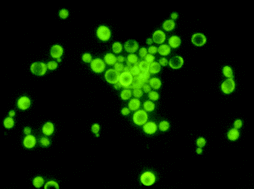Antimicrobial mechanisms behind photodynamic effect in the presence of hydrogen peroxide
Abstract
This study describes the use of

Maintenance work is planned for Wednesday 1st May 2024 from 9:00am to 11:00am (BST).
During this time, the performance of our website may be affected - searches may run slowly and some pages may be temporarily unavailable. If this happens, please try refreshing your web browser or try waiting two to three minutes before trying again.
We apologise for any inconvenience this might cause and thank you for your patience.
* Corresponding authors
a Centro de Pesquisa e Pós-Graduação São Leopoldo Mandic, Campinas-SP, Brazil
b Centro de Estudos, Treinamento e Aperfeiçoamento em Odontologia, São Paulo-SP, Brazil
c Departamento de Bioquímica, Instituto de Química, Universidade de São Paulo, São Paulo-SP, Brazil
d Universidade Federal do ABC, Santo André-SP, Brazil
e Departamento de Física Aplicada, Instituto de Física, Universidade de São Paulo, São Paulo-SP, Brazil
f Wellman Center for Photomedicine, Massachusetts General Hospital, Boston, MA, USA
g Department of Dermatology, Harvard Medical School, Boston, MA, USA
h Harvard-MIT Division of Health Sciences and Technology, Cambridge, MA, USA
i
Centro de Laser e Aplicações, Instituto de Pesquisas Energéticas e Nucleares, IPEN-CNEN/SP, Av. Lineu Prestes, 2242, Cidade Universitária, São Paulo-SP, Brazil
E-mail:
marthasr@usp.br
Fax: +55-11-31339374
Tel: +55-11-31339197
This study describes the use of

 Please wait while we load your content...
Something went wrong. Try again?
Please wait while we load your content...
Something went wrong. Try again?
A. S. Garcez, S. C. Núñez, M. S. Baptista, N. A. Daghastanli, R. Itri, M. R. Hamblin and M. S. Ribeiro, Photochem. Photobiol. Sci., 2011, 10, 483 DOI: 10.1039/C0PP00082E
To request permission to reproduce material from this article, please go to the Copyright Clearance Center request page.
If you are an author contributing to an RSC publication, you do not need to request permission provided correct acknowledgement is given.
If you are the author of this article, you do not need to request permission to reproduce figures and diagrams provided correct acknowledgement is given. If you want to reproduce the whole article in a third-party publication (excluding your thesis/dissertation for which permission is not required) please go to the Copyright Clearance Center request page.
Read more about how to correctly acknowledge RSC content.
 Fetching data from CrossRef.
Fetching data from CrossRef.
This may take some time to load.
Loading related content
